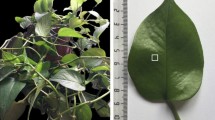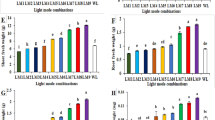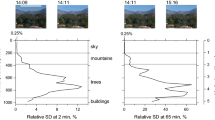Abstract
OWING to the great variability in growth-rate and tropic curvature of the coleoptile shown by oat (Avena) seedlings similarly treated, it is for many experimental purposes desirable to be able to take successive measurements of growth or curvature on the same individuals rather than on a fresh sample each time. Thus in experiments involving curvatures, in view of the difficulty in obtaining really straight seedlings to start with, doubtless partly due to nutation1, it is most desirable to have initial records before treatment; it may also be useful to record the degree and kind of curvature at successive intervals after stimulation or application of growth substance. This is, however, unsafe with the usual technique, in which the shadowgraphs are taken with white light, since the exposure itself induces curvature. Schneider and Went1 therefore constructed their ingenious “photokymograph” ; but this is only suitable for decapitated coleoptiles and for curvature but not growth measurements: it is, moreover, somewhat elaborate for routine or class use. The essence of the present technique is simply to use more-or-less panchromatic photographic paper for the successive shadowgraphs, and to make the exposures with light passed through an orange or red filter such that no phototropic or growth response can be detected even when the photographically necessary exposure is multiplied many times. These requirements have been met by the use of Kodak RP 15 “Reflex” paper and light from a tungsten filament lamp passed through a single layer of ‘Chromex 2202/C10’ orange cellulose acetate filter which has a cut-off at about 0.530 µ wave-length and a high transmission throughout the red. With a total intensity, at the position occupied by the seedlings, of 0.08 foot-candles, adequate shadowgraphs can be obtained with one minute's exposure. One hour's exposure of intact seedlings under these conditions has been found to cause no detectable growth response or subsequent curvature. It should therefore be safe to take a long series of successive records of the same seedlings.
This is a preview of subscription content, access via your institution
Access options
Subscribe to this journal
Receive 51 print issues and online access
$199.00 per year
only $3.90 per issue
Buy this article
- Purchase on Springer Link
- Instant access to full article PDF
Prices may be subject to local taxes which are calculated during checkout
Similar content being viewed by others
References
Schneider, C. L., and Went, F. W., Bot. Gaz., 99, 470 (1938).
Galston, A. W., Bot. Rev., 16, 361 (1950).
Author information
Authors and Affiliations
Rights and permissions
About this article
Cite this article
HEATH, O. A Technique for taking Successive Shadowgraphs of Oat Seedlings. Nature 168, 950–951 (1951). https://doi.org/10.1038/168950b0
Issue Date:
DOI: https://doi.org/10.1038/168950b0
This article is cited by
-
Coloured ‘Perspex’ for Darkroom Lights
Nature (1952)
Comments
By submitting a comment you agree to abide by our Terms and Community Guidelines. If you find something abusive or that does not comply with our terms or guidelines please flag it as inappropriate.



